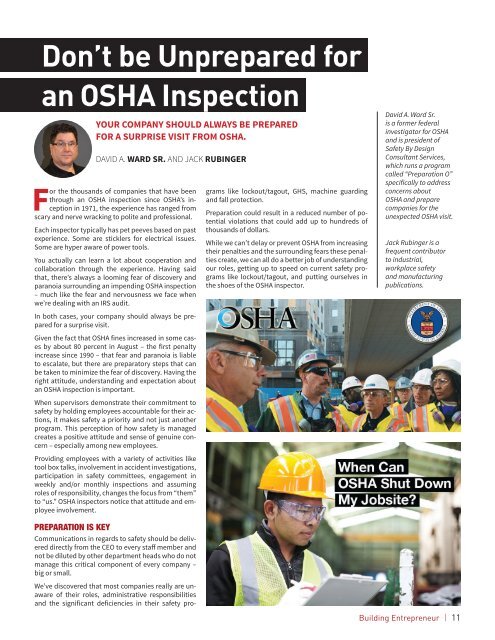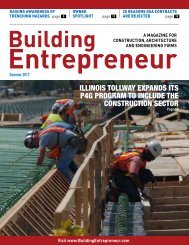Building_Entrepreneur_to print
Create successful ePaper yourself
Turn your PDF publications into a flip-book with our unique Google optimized e-Paper software.
Don’t be Unprepared for<br />
an OSHA Inspection<br />
YOUR COMPANY SHOULD ALWAYS BE PREPARED<br />
FOR A SURPRISE VISIT FROM OSHA.<br />
DAVID A. WARD SR. AND JACK RUBINGER<br />
For the thousands of companies that have been<br />
through an OSHA inspection since OSHA’s inception<br />
in 1971, the experience has ranged from<br />
scary and nerve wracking <strong>to</strong> polite and professional.<br />
Each inspec<strong>to</strong>r typically has pet peeves based on past<br />
experience. Some are sticklers for electrical issues.<br />
Some are hyper aware of power <strong>to</strong>ols.<br />
You actually can learn a lot about cooperation and<br />
collaboration through the experience. Having said<br />
that, there’s always a looming fear of discovery and<br />
paranoia surrounding an impending OSHA inspection<br />
– much like the fear and nervousness we face when<br />
we’re dealing with an IRS audit.<br />
In both cases, your company should always be prepared<br />
for a surprise visit.<br />
Given the fact that OSHA fines increased in some cases<br />
by about 80 percent in August – the first penalty<br />
increase since 1990 – that fear and paranoia is liable<br />
<strong>to</strong> escalate, but there are prepara<strong>to</strong>ry steps that can<br />
be taken <strong>to</strong> minimize the fear of discovery. Having the<br />
right attitude, understanding and expectation about<br />
an OSHA inspection is important.<br />
When supervisors demonstrate their commitment <strong>to</strong><br />
safety by holding employees accountable for their actions,<br />
it makes safety a priority and not just another<br />
program. This perception of how safety is managed<br />
creates a positive attitude and sense of genuine concern<br />
– especially among new employees.<br />
Providing employees with a variety of activities like<br />
<strong>to</strong>ol box talks, involvement in accident investigations,<br />
participation in safety committees, engagement in<br />
weekly and/or monthly inspections and assuming<br />
roles of responsibility, changes the focus from “them”<br />
<strong>to</strong> “us.” OSHA inspec<strong>to</strong>rs notice that attitude and employee<br />
involvement.<br />
grams like lockout/tagout, GHS, machine guarding<br />
and fall protection.<br />
Preparation could result in a reduced number of potential<br />
violations that could add up <strong>to</strong> hundreds of<br />
thousands of dollars.<br />
While we can’t delay or prevent OSHA from increasing<br />
their penalties and the surrounding fears these penalties<br />
create, we can all do a better job of understanding<br />
our roles, getting up <strong>to</strong> speed on current safety programs<br />
like lockout/tagout, and putting ourselves in<br />
the shoes of the OSHA inspec<strong>to</strong>r.<br />
David A. Ward Sr.<br />
is a former federal<br />
investiga<strong>to</strong>r for OSHA<br />
and is president of<br />
Safety By Design<br />
Consultant Services,<br />
which runs a program<br />
called “Preparation O”<br />
specifically <strong>to</strong> address<br />
concerns about<br />
OSHA and prepare<br />
companies for the<br />
unexpected OSHA visit.<br />
Jack Rubinger is a<br />
frequent contribu<strong>to</strong>r<br />
<strong>to</strong> industrial,<br />
workplace safety<br />
and manufacturing<br />
publications.<br />
PREPARATION IS KEY<br />
Communications in regards <strong>to</strong> safety should be delivered<br />
directly from the CEO <strong>to</strong> every staff member and<br />
not be diluted by other department heads who do not<br />
manage this critical component of every company –<br />
big or small.<br />
We’ve discovered that most companies really are unaware<br />
of their roles, administrative responsibilities<br />
and the significant deficiencies in their safety pro-<br />
<strong>Building</strong> <strong>Entrepreneur</strong> | 11







